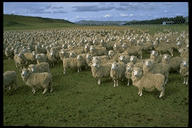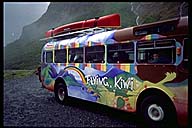Economy
from the New Zealand Handbook by Jane King,
which you can
order right now.
AGRICULTURE
New Zealand's major source of income comes from agriculture. It has
developed advanced techniques to use the country's rugged land, including
specially designed aircraft to replace land machinery. Many areas are highly
mechanized. About 50% of total export income comes from meat, dairy products,
and wool; the land supports some 68 million sheep and 4.8 million beef cattle.
New Zealand is one of the world's largest exporters of lamb and mutton, has a
growing beef industry (about 75% of which is produced in the North Island), and
supplies about 90 countries with meat (the major markets are the U.K., Iran,
Russia, Japan, U.S., and Canada). New Zealand is also one of the largest and
most efficient exporters of dairy products. The combination of a good growing
climate, stable rainfall, and lush grass year-round has produced an average
herd of about 120 cows; most of the 3.3 million dairy cows in the country are
Jerseys or Friesians (that's one cow per person!). Butter (mostly to the U.K.)
and cheddar cheese (mostly to Japan and the U.K.) are the major dairy exports,
but casein (mainly to the U.S.) and skim-milk powder (to a wide variety of
countries, mainly in Asia) are also in demand. New Zealand's rich and creamy
dairy products are among the best in the world--one taste and you'll be
convinced!
Sheep
 Sheep are a predominant part of the landscape throughout the whole of New
Zealand. New Zealand is the second-largest producer of sheep (after Australia)
and largest supplier of medium to coarse crossbred wool (for carpets,
upholstery, and clothing) in the world, with an average flock of about 1,800
sheep. In North Island hill country, sheep are farmed for their wool; the
fertile lowland farms (up to 25 sheep per hectare) specialize in lamb
production (mainly for the U.K. and Iran) and mutton production (mainly for
Russia and Japan). Teams of sheepshearers travel around the country from
woolshed to woolshed, many shearing more than 200 sheep each a day (don't miss
any opportunity to watch shearers in action--their speed and dexterity are
really something). Most of the medium-to-coarse crossbred wool used for
carpetmaking and knitting yarn comes from romney sheep; the fine wool used for
soft fabrics and high-quality yarn comes from merino sheep. High-quality
sheepskins are a popular tourist purchase.
Sheep are a predominant part of the landscape throughout the whole of New
Zealand. New Zealand is the second-largest producer of sheep (after Australia)
and largest supplier of medium to coarse crossbred wool (for carpets,
upholstery, and clothing) in the world, with an average flock of about 1,800
sheep. In North Island hill country, sheep are farmed for their wool; the
fertile lowland farms (up to 25 sheep per hectare) specialize in lamb
production (mainly for the U.K. and Iran) and mutton production (mainly for
Russia and Japan). Teams of sheepshearers travel around the country from
woolshed to woolshed, many shearing more than 200 sheep each a day (don't miss
any opportunity to watch shearers in action--their speed and dexterity are
really something). Most of the medium-to-coarse crossbred wool used for
carpetmaking and knitting yarn comes from romney sheep; the fine wool used for
soft fabrics and high-quality yarn comes from merino sheep. High-quality
sheepskins are a popular tourist purchase.
Crops
Most of the crops--wheat, barley, maize, oats, vegetables, berry fruit, and
tobacco--are grown for the local market. However, malting barley, herbage
seeds, some herbs, and oilseed rape have become export crops. Grass and clover
seed markets have developed in the U.S., the U.K., and Australia. The citrus
export industry has grown dramatically as kiwifruit, tamarillos,
feijoas, and passionfruit have increased in popularity worldwide; apples
and pears are also important exports. Orchards in the North produce apples,
apricots, peaches, plums, nectarines, berryfruit, cherries, lemons, and
oranges, mostly for local consumption, but increasingly for export. Hops and
tobacco leaf (plus orchard fruit) are grown for the local market in the warm,
sunny Nelson area of the South Island.
INDUSTRY
Timber
After agriculture, forestry is New Zealand's next important industry. More than
27% of the country is covered by forest--about 1.2 million hectares of
production plantation forest and 6.2 million hectares of indigenous forests. As
native trees are very slow-growing, they are used for special purposes only.
The planted forests of exotic radiata pine are the major suppliers of New
Zealand's timber. Radiata grows rapidly here, producing a high amount of usable
wood per tree. Forest export products consist of timber, wood pulp and chips,
paper, building boards, plywood, veneers, and various oils. Australia and Japan
are New Zealand's largest customers of forest product exports.
Manufacturing
Many basic industries, such as textiles and leather goods, tobacco, rubber and
plastics, fruit and vegetables, building supplies, and furniture, are
flourishing in New Zealand. Light manufacturing provides an increasing range of
both consumer and industrial goods. Aircraft manufacture, motor vehicle
assembly, and the textiles and garment industry all provide employment. Two
steel companies in New Zealand make heavy equipment from imported steel.
Engineers have made many advancements in highly specialized electronic
equipment for agriculture, medicine, and veterinary science.
Energy
New Zealand does not have large mineral deposits and so relies heavily on
imported raw materials to manufacture chemicals. Imported petroleum supplies
almost 50% of New Zealand's energy needs; hydroelectricity, natural coal and
gas, solar energy, and geothermal steam supply the rest. Nuclear power is not
foreseeable in New Zealand's future (hooray!), the country's objective being to
harness its own natural power resources. Newer ventures include oil refining,
aluminium smelting, and ironsand deposit mining, processing New Zealand's
offshore oil and gas condensates, and processing associated with steel and
glass production. At Lake Grassmere in Marlborough, the first solar salt works
in the country converts seawater from the mudflats into household and
industrial salt through evaporation. Schemes to change natural gas into
synthetic petrol are promoted and encouraged by the government, and solar units
to heat household water are increasing in popularity as an alternative to
electricity.
Tourism
 Tourism is a major part of the New Zealand economy. In fact, it is the top
earner of foreign exchange. The New Zealand Tourism Board does an
excellent job of developing facilities while maintaining the natural and
cultural aspects of the country; the department also promotes New Zealand
overseas. The majority of visitors flock across from Australia; however, more
and more visitors from North America, Japan, the U.K., Europe, and Taiwan are
discovering New Zealand.
Tourism is a major part of the New Zealand economy. In fact, it is the top
earner of foreign exchange. The New Zealand Tourism Board does an
excellent job of developing facilities while maintaining the natural and
cultural aspects of the country; the department also promotes New Zealand
overseas. The majority of visitors flock across from Australia; however, more
and more visitors from North America, Japan, the U.K., Europe, and Taiwan are
discovering New Zealand.
[ Back | Up to cover page | On to People ]
Add a comment | Add a link
 Sheep are a predominant part of the landscape throughout the whole of New
Zealand. New Zealand is the second-largest producer of sheep (after Australia)
and largest supplier of medium to coarse crossbred wool (for carpets,
upholstery, and clothing) in the world, with an average flock of about 1,800
sheep. In North Island hill country, sheep are farmed for their wool; the
fertile lowland farms (up to 25 sheep per hectare) specialize in lamb
production (mainly for the U.K. and Iran) and mutton production (mainly for
Russia and Japan). Teams of sheepshearers travel around the country from
woolshed to woolshed, many shearing more than 200 sheep each a day (don't miss
any opportunity to watch shearers in action--their speed and dexterity are
really something). Most of the medium-to-coarse crossbred wool used for
carpetmaking and knitting yarn comes from romney sheep; the fine wool used for
soft fabrics and high-quality yarn comes from merino sheep. High-quality
sheepskins are a popular tourist purchase.
Sheep are a predominant part of the landscape throughout the whole of New
Zealand. New Zealand is the second-largest producer of sheep (after Australia)
and largest supplier of medium to coarse crossbred wool (for carpets,
upholstery, and clothing) in the world, with an average flock of about 1,800
sheep. In North Island hill country, sheep are farmed for their wool; the
fertile lowland farms (up to 25 sheep per hectare) specialize in lamb
production (mainly for the U.K. and Iran) and mutton production (mainly for
Russia and Japan). Teams of sheepshearers travel around the country from
woolshed to woolshed, many shearing more than 200 sheep each a day (don't miss
any opportunity to watch shearers in action--their speed and dexterity are
really something). Most of the medium-to-coarse crossbred wool used for
carpetmaking and knitting yarn comes from romney sheep; the fine wool used for
soft fabrics and high-quality yarn comes from merino sheep. High-quality
sheepskins are a popular tourist purchase.